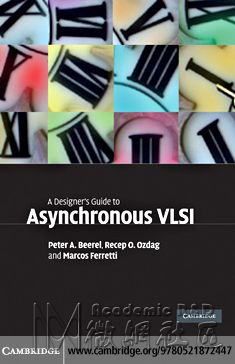
A Designer’s Guide to Asynchronous VLSI
Create low power, higher performance circuits with shorter design times using this
practical guide to asynchronous design. This practical alternative to conventional
synchronous design enables performance close to full-custom designs with design
times that approach commercially available ASIC standard cell flows. It includes
design trade-offs, specific design examples, and end-of-chapter exercises. Emphasis
throughout is placed on practical techniques and real-world applications,
making this ideal for circuit design students interested in alternative design styles
and system-on-chip circuits, as well as for circuit designers in industry who need
new solutions to old problems.
Peter A. Beerel is CEO of TimeLess Design Automation – his own company
commercializing asynchronous VLSI tools and libraries – and an Associate Professor
in the Electrical Engineering Department at the University of Southern
California (USC). Dr. Beerel has 15 years’ experience of research and teaching in
asynchronous VLSI and has received numerous awards including the VSoE
Outstanding Teaching Award in 1997 and the 2008 IEEE Region 6 Outstanding
Engineer Award for significantly advancing the application of asynchronous
circuits to modern VLSI chips.
Recep O. Ozdag is IC Design Manager at Fulcrum Microsystems and a part-time
Lecturer at USC, where he received his Ph.D. in 2004.
Marcos Ferretti is one of the founders of PST Electroˆ nica S. A. (Positron), Brazil –
an automotive electronic systems manufacturing company – where he is currently
Vice-President. He received his Ph.D. from USC in 2004 and was co-recipient of
the USC Electrical Engineering-Systems Best Paper Award in the same year.
CAMBRIDGE UNIVERSITY PRESS
Cambridge, New York, Melbourne, Madrid, Cape Town, Singapore,
São Paulo, Delhi, Dubai, Tokyo
Cambridge University Press
The Edinburgh Building, Cambridge CB2 8RU, UK
First published in print format
ISBN-13 978-0-521-87244-7
ISBN-13 978-0-511-67549-2
© Cambridge University Press 2010
2010
Information on this title:
www.cambridge.org/9780521872447
This publication is in copyright. Subject to statutory exception and to the
provision of relevant collective licensing agreements, no reproduction of any part
may take place without the written permission of Cambridge University Press.
Cambridge University Press has no responsibility for the persistence or accuracy
of urls for external or third-party internet websites referred to in this publication,
and does not guarantee that any content on such websites is, or will remain,
accurate or appropriate.
善用搜索,充分合理利用社区资源,以期更好的学习交流!
"纯净、朴素、免费、共享、学术研发"始终是我们坚持的根本
http://www.mwtee.com

